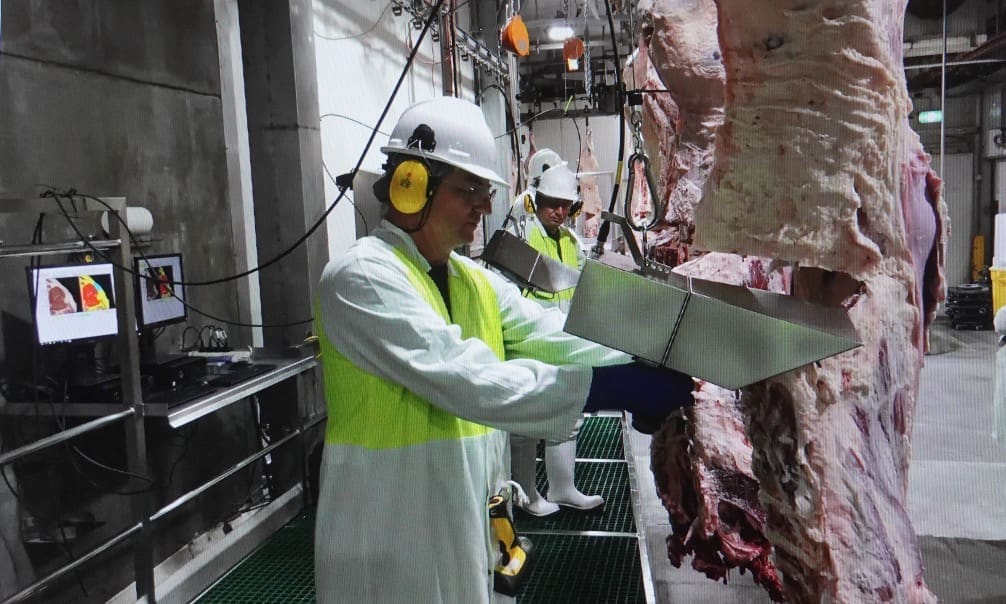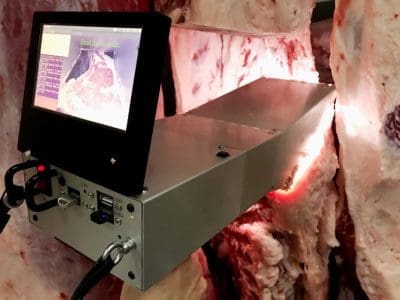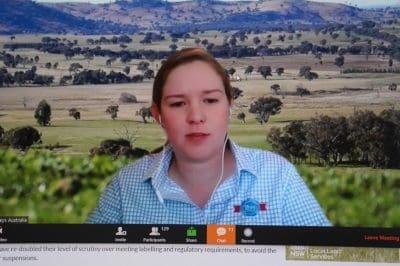
One of three E+V cameras undergoing trials on carcases at Teys Australia’s Wagga processing plant.
A GROWING suite of promising objective carcase measurement tools are in various stages of assessment, testing and implementation in the Australian beef industry.
As Beef Central reported in this article published in February, provisional approval has already been granted by the AusMeat Language and Standards Committee for the use of a piece of objective digital camera technology in performing some Meat Standards Australia grading tasks.
Teys Australia is set to be the first processor to implement the E+V camera-based MSA grading technology, at the company’s Wagga Wagga facility in NSW, and expects to roll-out in other sites in coming months.
The E+V camera, and a suite of other promising new technologies designed to evaluate meat quality traits, was the subject of a webinar held yesterday, hosted by the Inter Collegiate Meat Judging Association.
University of New England meat scientist, Dr Peter McGilchrist said through the industry’s Advanced Livestock Measurement Technologies (ALMTech) program, some incredible new technologies were being developed that would change the way meat eating quality is assessed, aiding improved segregation and better consistency of products that are delivered to customers around the world.
Dr McGilchrist said it was not uncommon for some technologies like this to take a long time to get to commercial release stage, having to pass through four distinct stages.
The first of these was the research and development of the concept, after somebody had the ‘lightbulb moment’ to see an opportunity to ‘use this’ to ‘measure this.’
The next was the validation phase, where the focus was on answering the question, ‘can this piece of technology actually measure what it aims to measure?’
“Once we prove that it can, and it gets through all of the accreditation phases, it can move into commercialisation,” Dr McGilchrist said. “The commercial developers have to work on who is going to buy it; and when, where and how are they going to use it.”
“This is not a rapid or cheap process, and it takes good collaboration between companies, researchers and the tech developers themselves. We all have to rely on each other,” he said.
One of the key requirements was ‘training’ or ‘calibrating’ a piece of technology, using collected data.
“This data helps us generate an equation – the difference between the actual trait value, and the value it is given by the technology. Some technologies require only a little training and calibration data, while others require a great deal of data. But once we get that relationship between the actual trait value and the technology’s trait value pretty close, then we move into the validation phase – basically, how close does it get to the actual result.”
Accuracy and ‘transportability’ of the technology was also important.
Cut surface technologies
Dr McGilchrist highlighted a number of ‘cut-surface’ objective assessment technologies – so called because they use the quartering site in a beef carcase to make their assessment – that are in various stages of development.
To do that, researchers needed to measure lots of traits in the cut surface for either AusMeat grading or MSA grading, to determine levels of meat quality. These included rib fat depth – a tricky one – MSA and AusMeat marbling score, meat colour, eye muscle area and fat cover.
Under current manual grading conditions, the grader goes into the chiller in the middle of the night or very early morning, and assesses carcases from a grading station, using reference chips and a computer data entry tool.
“These are trying conditions, and to be fair, humans are humans. We’re all good one day, and not so good the next,” Dr McGilchrist said. “But humans are actually the best technology for this purpose that we currently have to do this job.”
The real question is: Can cameras assist these manual graders to do their job better?
“That’s where this process is at – bringing these technologies into grading,” Dr McGilchrist said.
“It’s not about replacing graders, because they will still have to use the cameras to take the measurement, and over-ride some of the outcomes, if they don’t agree, because there are a whole heap of times when the cut surface is not ideal to make an assessment using a technology. That’s when the graders are really important, to deal with those necessary over-rides,” he said.
Trials in the past have demonstrated grader variability when assessing the same set of carcases, over different time points. In one trial, a camera technology was about 40pc more accurate than three human graders, in terms of repeatability on the same carcases.
“Reducing the variability between time points, or between animals, is where the value is in introducing these new technologies,” Dr McGilchrist said.
“Getting the same score consistently day after day, and across plants, and across seasons is the key.”
New technologies: where are they up to?
Dr McGilchrist summarised a number of new technologies that are currently under examination, and where they are up to:
Frontmatic Loin-Eye camera
The Frontmatic Loin-Eye camera is a prototype hyper-spectral camera that takes multiple images at different light wave lengths. It does a ‘pretty good’ job of measuring eye muscle area, and MSA marbling score, meat colour and fat colour. The developers are confident enough that the prototype will measure all the traits accurately enough to meet AusMeat accreditation guidelines, that the company has now approved the development of a commercial version of the camera. That camera should be back in Australia towards the end of this year, for more training and validation.
Meat Industry Japan camera

The MIJ camera captures a rib eye image from a Wagyu carcase
Developed for grading Wagyu in Japan, scientists have worked extensively with the MIJ camera over the past few years. Algorithms have now been developed for MSA and AusMeat marbling assessment, using 1200 carcases and seven different data sets. What the data shows is that there is low variation between cameras, and they gives the same score quite consistently. There is still some further work to be done on training data, to prove the algorithms for MSA traits.
VIAScan camera
While the VIAScan camera was a pioneer in the objective carcase measurement space, it has come back ‘on the scene’ in 2018, since being taken over by meat processing technology giant, Marel. The camera uses red/green/blue vision camera technology, is already hand-held, and has previously been used in a number of plants to grade for Woolworths. The technology is being revised and upgraded, and new MSA traits added. Tests on two large data-sets proved the VIAScan units were already ‘pretty good’ in their tightness and accuracy of prediction. The developer, Cedar Creek continues to make the device more accurate and easier to use. ALM is working with the company to do more repeatability trials, and look at the variation between cameras, before moving towards AusMeat accreditation.
MasterBeef Camera
A new entry into the cut-surface assessment space is the MasterBeef camera, developed by Queensland Wagyu breeder, Darren Hamblin. The technology is unbelievably simple, compared with others in this list. It relies on hand-held smart-phone cameras – either Google Pixel 2-4 cameras, or a Samsung A70, and potentially, i-phones. The MasterBeef 3 app on the phone is used to generate a suite of data from the photo image, including IMF, marbling score, eye muscle area, marbling fineness and distribution, meat colour and fat colour. Work is now focusing on developing calibration and validation on all traits, and scrutinising the repeatability between systems and set-ups. The intention was to move the technology towards AusMeat accreditation ‘as quick as it can.’ Beef Central will discuss the camera in a separate upcoming article.
E+V camera
As mentioned above, and in further detail below, the E+V camera has received preliminary AusMeat approval for marbling score, meat and fat colour traits. Final approval was due to occur at the end of March, but was delayed due to COVID.
Processor perspective
Yesterday’s webinar also included a processing sector perspective with Jasmine Green from Teys Australia, discussing the commercial application and implementation of technology to assist with MSA grading of beef carcases.

Teys Australia’s Jasmine Green presenting during yesterday’s webinar
“Not all carcases are created equal,” Ms Green said. “The capture of the grading information against the individual carcase allows us to sort those carcases into suitable processing runs, based on similar categories and eating qualities, under company brands. This ensures that when sending a carton of beef to a customer, that all the pieces in the box have the same eating quality and deliver a similar eating experience each time,” she said.
The other benefit of grading information was in providing effective feedback to suppliers, allowing them to make more informed decisions on farm.
Ms Green pointed to several recent calls from industry to move towards more objective forms of carcase assessment.
“There are already several technologies that are approved under the USDA grading system in the United States, already in use. These instruments are able to measure several different variables present in the exposed rib-eye area, which are then used in USDA quality grading of carcases,” she said.
One of those technologies was the VBG2000 camera, developed by the USDA and commercialised by the E+V company in Germany.
“From our perspective as a processing company in Australia, we were looking for something that already has the runs on the board, and is proven to be ready to go, commercially,” Ms Green said.
The E+V cameras were specifically designed for quality grading of beef carcases, and have been successfully implemented into commercial processor settings in the US industry. Some US plants using the technology are processing up to 5000 head each day, so the cameras are obviously robust enough to cope with the harsh environmental conditions in the chillers.
But it was not quite as simple as bringing a camera designed for US operations to Australia, and ‘plugging it in.’
“The E+V camera in the US is obviously set up to provide the outputs to achieve a USDA grading score, which obviously are not applicable under Australian grading systems, and how we sell and market our beef,” Ms Green said.
One of the first tasks was to develop a suitable process to calibrate and train the E+V camera on how to assess AusMeat and MSA carcase assessment criteria.
“A lot of work has gone into that, collecting data, designing an algorithm and testing that against other data sets,” she said.
A number of trails were conducted by Teys last year, over about 1400 head of cattle, also taking into account the accuracy and repeatability of the E+V cameras, and the performance from one camera to another.
Has it worked?
Once Teys was happy that the E+V cameras were able to provide the correct outputs under the AusMeat language, the trial data and comparisons with manual graders was provided to the AusMeat language and Standards Committee for review.
As described above, AusMeat preliminary approval has now been received for Ausmeat and MSA marbling, meat colour and fat colour. Other traits in the MSA grading model, such as pH, hump height, fat distribution and oss, continue to be assessed manually.
One final review stage remains, in on-site verification, which will be completed after COVID-19 travel restrictions are lifted.
The camera grading process, once it starts in earnest at Teys Wagga, will be audited regularly, in much the same way that current manual grading is monitored, Ms Green said. Once embedded at Wagga, Teys plans to install the technology at a number of other company processing sites.
“Obviously there has been some delays around that process due to COVID-19, and each of our processing sites are set up quite differently, so some time will have to be spent in making sure we can apply the process at other sites,” she said.
What else is in the pipeline?
In a second session during the webinar, Peter McGilchrist outlined a sample of other emerging technologies that might one day add to the cut surface gradin technologies in building a better picture of carcase quality.
In lamb, for example, there was a need to develop an ability to measure marbling (without quartering the carcase). “That is a huge industry need,” Dr McGilchrist said.
SOMA NIR device
Japanese company SOMA has developed a near-infra-red spectroscopy device to measure fat levels in tuna meat. Early tests using the technology on lamb would deliver a ‘number’ but it made little sense, as the technology is calibrated only for tuna at this stage. “We have to train the device to measure what we want it to measure,” he said. In early work, it worked quite well in topsides, and more calibration work is taking place.”
Frontmatic loin eye camera
Also joining the race to distinguish IMF in lamb carcases is the Frontmatic loin eye camera, which has now collected 1200 lamb images, results from which are pending. However there are separate challenges in analysing lamb and beef carcases, and the Frontmatic was primarily designed for beef.
MEQ probe
The ALM group continues to work with the MEQ probe technology, which continues to be developed. The device now uses two probes, and has a much wider range of light detection. MEQ is currently involved in further development projects with MLA and AMPC. Fresh results are expected in October.
Optical coherence tomography
Another new technology being examined is Optical Coherence Tomography. The technology is used in humans, using a fine needle containing a miniature camera, during brain surgeries, looking for margins between brain matter and blood vessels. The potential is to scan hot or cold lamb carcases for IMF. The probe measures the amount of white/black specs s it passes through muscle, to gauge the amount of intramuscular fat. Early results on tests using 200 lamb carcases suggest the technology has merit. It may also have future applications in beef systems. More deep learning algorithms are being developed.
Nuclear magnetic resonance
This technology is looks at the relaxation spectrum after changing the polarity in cells in a sample of meat. The meat in the protype sits in a pot in the middle of a magnet. The magnet then charges the meat to change the direction of the charged cells, and then releases that energy and simply measures the rate of relaxation. It has potential to be highly accurate, once improvements are made, using a new paddle technology that will connect with the surface of a beef or lamb carcase.
Other future potential eating quality traits that could in future be measured objectively in carcases included connective tissue (directly correlated to eating quality), shear force, enzyme levels, water-holding capacity, sarcomere length and fatty acid profiles.
“We already have some technologies around that can measure some of these traits,” Dr McGilchrist said.
“This is a never-ending quest, because the more of these traits we can explain, the better our prediction algorithms can become for both beef and lamb, and from there, more consistent product for our consumers,” he said.
“Lastly, such technologies ‘need to be needed’; they need to be commercially relevant; help optimise or advance the red meat industry in some way; and generate greater value along the supply chain.”
Questions
There was a bunch of questions thrown at the presenters at the end of the webinar.
One listener asked how manual graders’ skills levels would be maintained, once ‘routine’ grading was performed using the camera systems.
“Accredited graders will still need to undergo the same training that a normal grader would, and that will include the routine validation/correlation process that all graders must pass every six weeks. There is always the need to have a manual back-up plan, if for some reason the cameras fail,” Ms Green said.
Another question asked whether the cameras saved or added time during the grading process.
“The time to capture and output the image is less than a second. It definitely does save a little time over the manual grade, once chips are involved. The US experience sees up to 5000 head per day graded using cameras, in some plants,” Ms Green said.
Responding to a question about the cost of installing cameras versus manual grading, Dr McGilchrist said the real value benefit was in the value of consistency in a company’s beef brands.
“It’s quite hard to put a value on it, but it’s really important in getting that consistency of eating quality to make sure we get those repeat sales, in what is a very competitive environment in meat sales.”
Asked whether the industry would eventually reach a stage of ‘full automation’ in carcase grading, without human intervention, Dr McGilchrist said it might be more likely in lamb, because of more consistency in carcase size and shape, but would be much more difficult in beef.
